Digital Job Cards: The Top Job Card Solution for U.S. Manufacturin
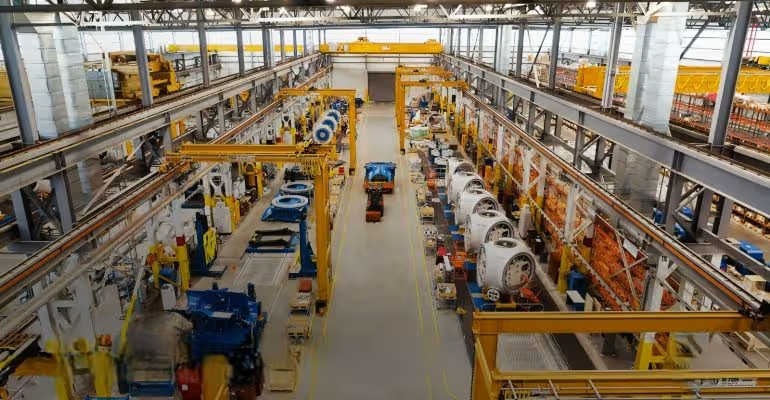
Digital Job Cards: The Top Job Card Solution for Manufacturing
For more than fifteen years, I've worked as an IoT Engineer, setting up smart factory tools in all kinds of places across the United States. I've been in bustling automotive plants in Michigan, cutting-edge aerospace facilities in Washington, and even food processing operations in California. I've learned one crucial thing: how smoothly data moves on the factory floor directly affects how efficient you are. For leaders and managers in U.S. manufacturing units, making production better means fixing issues at every level. We often don't give enough thought to the "job card." When we make it digital, this simple card becomes a powerful way to get real-time data. This directly changes how much you produce, the quality of your products, and, most importantly, your profits.
This guide will explain what is a job card in manufacturing. We'll look closely at why old, manual systems cause so many problems. Then, we'll dive deep into how a digital job card solution can completely change how you work.
We'll see how these new systems fit with what you already use, the real benefits they bring, and what you, as a U.S. manufacturing leader, need to consider when putting in a modern job card system.
I've personally helped over 50 clients, using advanced tools from companies like Rockwell Automation, Siemens, and PTC, to deliver huge jumps in how they operate.
A job card in manufacturing details a specific task, materials, steps, and time for production. A digital job card solution automates this process, greatly improving operations for U.S. factories.
What Is a Job Card in Manufacturing?
At its heart, a job card in manufacturing, sometimes called a work order or route sheet, is a key document that tells you exactly what to do for a certain task. For a long time, these were paper cards. They physically moved with a product or part through all its production steps, collecting notes as they went. For factories across the United States, from huge assembly lines in places like South Carolina to small, specialized workshops in Vermont, the manufacturing job card has always provided step-by-step instructions for production.
Think about a typical day at a U.S. factory making custom metal parts.
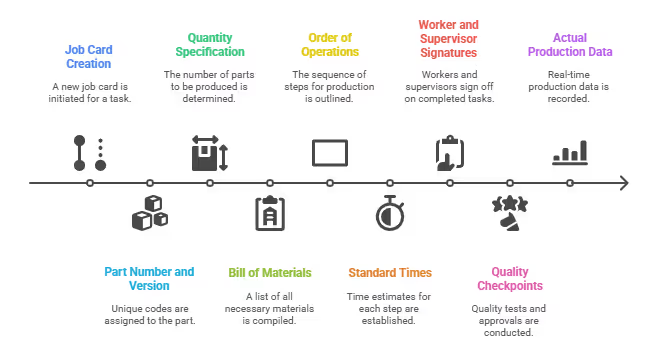
A production job card for a specific bracket might list:
- Part Number and Version: Unique codes for the part, including any changes made to the design.
- Quantity: How many parts need to be made in this group.
- Bill of Materials (BOM): A full list of all raw materials, smaller parts, and items needed. Often, it includes supplier and batch numbers so you can track everything.
- Order of Operations: The exact steps to make the part. This means saying which machines to use (like a CNC mill or a press brake), what tools are needed, and which skilled workers should do each step (such as cutting, bending, welding, or inspection).
- Standard Times: How long each step is supposed to take. This is vital for planning production and figuring out costs in American factories.
- Worker and Supervisor Signatures: Spaces for people to sign off when they finish a task. Often, they also add the time.
- Quality Checkpoints: Specific places where quality tests, measurements, or approvals must happen. These often point to U.S. quality standards like ISO 9001 or specific industry certifications.
- Actual Production Data: Areas to write down the real start and end times, machine settings, defects found, and how much material was wasted.
While the paper job card in manufacturing has been crucial for controlling factory floors in the U.S. for decades, providing a clear record and making sure work follows a set path, its old-fashioned paper format creates big problems for today's fast and highly competitive American manufacturing scene.
The Drawbacks of Manual Manufacturing Job Card Systems
My long career working with U.S. manufacturers, from big automotive suppliers in the Midwest to niche medical device producers in California, consistently highlights the serious inefficiencies caused by relying on paper manufacturing job card systems. These aren't minor issues; they directly harm your efficiency, data accuracy, and ability to make quick decisions.
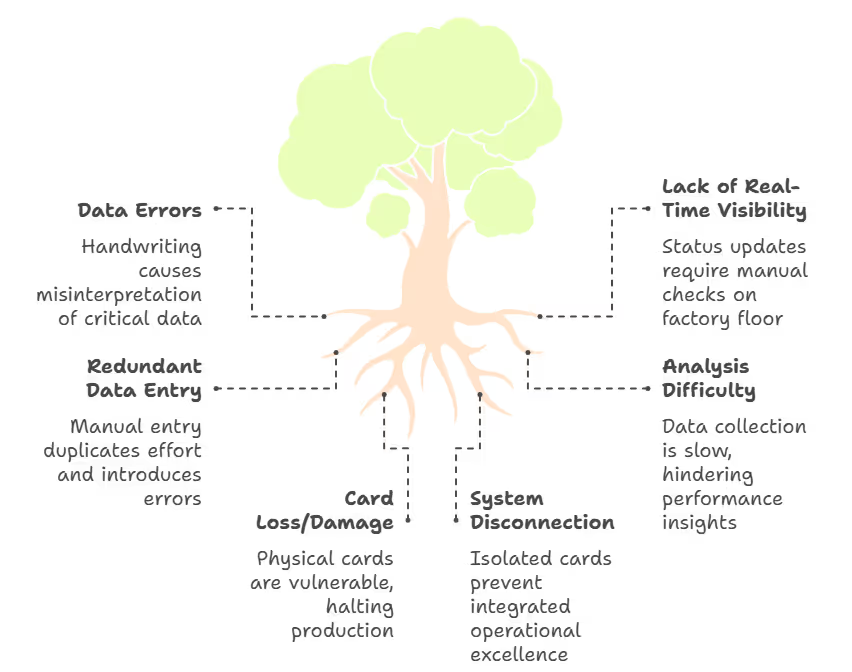
This is a major concern for U.S. manufacturing unit leaders and managers.
- Wrong Data and Unreadable Notes: When people write things by hand, mistakes happen easily. It’s hard to read messy handwriting. I remember a project at a custom machinery builder in Wisconsin. Someone misread dimensions on a job card for production. This led to a lot of wasted material and expensive rework on large components. It directly hurt their profits and caused late deliveries for a key customer.
- No Live View: Paper job cards do not show what is happening right now with a job. If a supervisor in a U.S. factory wants to know the status of an order, they usually have to walk around the factory floor, find the physical card, and manually check its last update. This slow flow of information means you only react to problems after they've already happened. Imagine trying to give an exact, confident delivery date to a demanding U.S. customer when your production data is hours, or even a full work shift, behind.
- Too Much Manual Data Entry: All the information carefully written on paper job cards eventually needs to go into your ERP or MES. This manual entry takes a lot of time away from other important production work. Plus, it creates another chance for mistakes when someone types in the data. This makes your main systems less accurate.
- Hard to Analyze and Report: Gathering data from hundreds or thousands of paper production job cards to see how well you're doing, find bottlenecks, or spot new trends is a huge, slow job. Often, the data isn't even complete. Calculating important numbers like OEE or finding common quality issues becomes a tedious task done after the fact, not a quick insight for U.S. manufacturers.
- Cards Get Lost or Damaged: Paper job cards can easily get misplaced, ruined, or destroyed in the tough environment of a U.S. factory floor. When this happens, vital production data is lost forever, and work stops. I've personally seen whole production batches stop at a plant in Ohio because a critical job card for production went missing. They had to print all new instructions, and shipments were delayed.
- Don't Connect to Other Systems: Manual job cards in manufacturing work alone. They don't link up with inventory systems, automated quality control, or real-time machine data. This means information is spread out. You have to manually check it across different departments. This disconnected way of working prevents real operational excellence in U.S. manufacturing.
These ongoing problems show a clear truth for U.S. manufacturing: the idea of a job card is still vital, but using old paper cards just doesn't work anymore. Modern factories need to be highly efficient and competitive. This is why a digital job card solution is not just helpful, but absolutely necessary.
Digital Job Cards: A Smart Job Card Solution for U.S. Operations
A digital job cards solution is a smart software system. It completely replaces paper job cards in manufacturing with electronic, interactive versions. This allows you to capture, manage, and analyze manufacturing data as it happens. From my view as an IoT Engineer, it's a core part of Industry 4.0. It bridges the gap between the factory floor and the digital systems that U.S. manufacturing needs to stay strong.
Basically, a solid digital job cards platform gives you an easy-to-use screen. You can access it on tough tablets, industrial computers, or even secure mobile devices right on the factory floor.
With it, workers can:
- See Clear Work Instructions: Access detailed instructions with pictures, videos, or 3D models for their tasks. This cuts down on mistakes and speeds up training, which is a big help with the skilled labor challenges in the U.S.
- Record Progress Instantly: Mark tasks as done, enter how many parts they made, how much was wasted, and why machines stopped. They do this right when it happens.
- Find Information Fast: Quickly look up material lists, engineering drawings, quality checklists, safety rules (like OSHA guidelines), and maintenance logs. They don't have to leave their workstation or look for papers.
- Give Feedback Right Away: Log problems, ask for maintenance, or suggest ways to make things better directly through the system. This helps U.S. manufacturers keep improving.
- Automate Data Collection: In advanced setups, digital job cards can connect directly to machines using sensors or PLCs. This means they automatically record things like how long a job takes, if a machine is running, and how many items were produced. This cuts down on manual work and makes data much more reliable.
These systems are much more than just digital forms. They are smart, active systems that connect data points that used to be separate across the whole manufacturing process.
This gives you a complete view of production.
Implementing a Modern Job Card Platform in American Factories
For manufacturing leaders and managers in the United States, putting in a modern job card platform is a critical step. It helps you work better and stay competitive in the global market. The American manufacturing sector, with its many industries and tough quality rules, gains a lot from this digital shift.
From my own experience setting up these systems in various U.S. factories, here are key things for American manufacturers to consider:
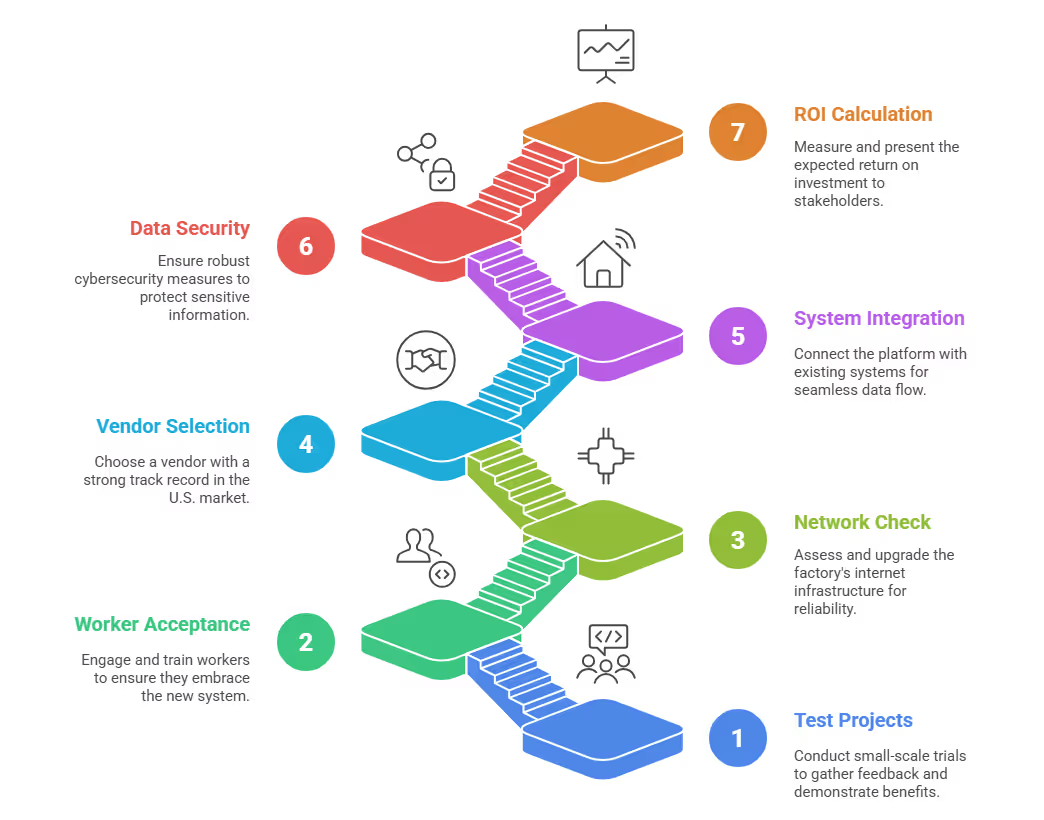
- Test Projects Are Crucial for Buy-in: Start with a small, focused test project on one specific production line or department. This lets your team try the system in real life, get important feedback from workers, and clearly show the benefits before a full rollout. This step-by-step approach causes less disruption and builds strong support among your U.S. workforce, which is key for new technology to be adopted successfully.
- Focus on Worker Acceptance and Training: Any digital tool on the factory floor will only work if your workers accept it. Get your operators and frontline supervisors involved early when you're choosing and setting up the system. Give them thorough, hands-on training. Show them how the new system makes their jobs easier, not just management's. An easy-to-use screen and clear digital work instructions are most important.
- Check Your Internet/Network: Look at your factory floor's current internet setup (Wi-Fi, wired connections). Some older U.S. factories might have areas with poor signal or old networks. Make sure the system you choose can work well offline and syncs data when it reconnects. This stops work from stopping because of network problems.
- Pick the Right Vendor: Choose a software company with a strong history, especially in the U.S. manufacturing market. Look for companies that understand how American factories work, know about U.S. rules (like FDA for medical devices or car industry standards), and offer good local technical support. Reputable MES providers like Plex Systems, Epicor, or specialized local firms often have the right expertise for the U.S. market.
- Connect It to Your Current Systems: This is the most important part. A digital job card platform working alone doesn't do much. Make sure the system you choose can link smoothly with your current ERP (like SAP, Oracle, Microsoft Dynamics), MES, SCADA/PLC systems, and quality management software. Strong APIs (Application Programming Interfaces) are a must for data to flow both ways. This makes sure production orders are received correctly, and real-time production data goes back to your main systems for full analysis.
- Keep Your Data Safe and Follow Rules: For U.S. manufacturers, data security is non-negotiable. Production data, company secrets, and special processes must be protected very carefully. Make sure the platform you pick follows good cybersecurity rules and industry-specific compliance standards (like NIST guidelines for defense companies or HIPAA for certain health-related data).
- Figure Out the Return on Investment (ROI): Before you commit to a big investment, clearly define and measure the expected return. This could mean less waste, faster deliveries, lower admin costs, or making more products. Showing these benefits clearly to your U.S. stakeholders will help get leaders to agree and show the long-term value.
The Impact of a Modern Job Card System
Putting in a well-designed job card system completely changes how you manage work in American factories.
Switching from paper to digital unleashes a flood of benefits that directly address common problems for U.S. manufacturing leaders and managers.
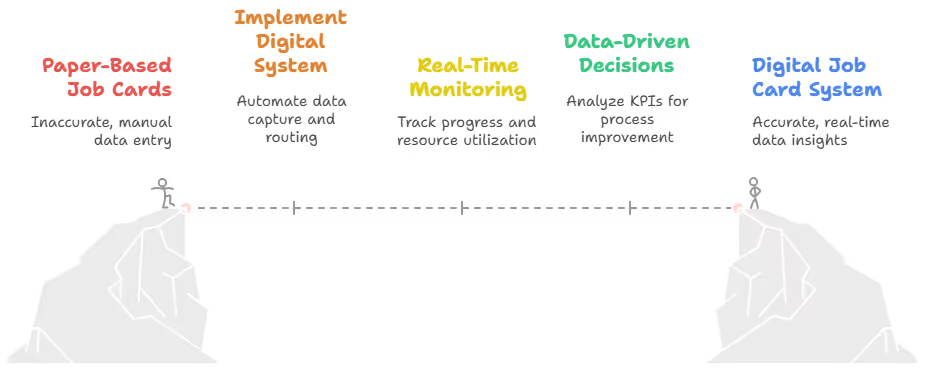
Get Real-time Information and More Accurate Data
One of the biggest and fastest benefits is much better data accuracy and being able to see what's happening right now. When you input data digitally, and often get it automatically from machines, the chance of human errors in writing things down almost disappears.
- Example from the U.S.: I worked with a large heavy machinery manufacturer in Illinois. They always struggled with wrong production counts, which messed up their supply chain. After putting in a digital job card system that linked to automatic counting sensors at key assembly spots, their inventory mistakes dropped by 90% in eight months. This meant better planning for materials, less urgent ordering, and better relationships with their suppliers all across their U.S. network.
- Live Dashboards: Factory leaders get instant access to live screens showing the status of every job, how much machines are being used, how well workers are doing, and where problems might be. This helps them make decisions quickly. Imagine a plant manager in South Carolina instantly seeing an unexpected slowdown on a key CNC machine and sending a maintenance team right away, stopping a long break in production.
Better Workflows and Less Office Work
A strong digital job card system automates many manual tasks that paper job cards in manufacturing used to create.
This frees up valuable people.
- Automatic Routing: Jobs can automatically move to the next workstation or production step once an operation is digitally signed off. This stops delays and manual tracking.
- No More Paperwork: You print, distribute, and file much less paper. This means administrative staff can do more important work instead of just managing physical documents.
- Faster Information: News about job progress, quality issues, or missing materials goes out instantly to all needed departments, from production planning to quality control, engineering, and even sales teams. Everyone stays connected.
Make More Products and Work Better
With clear, easy-to-find instructions and instant feedback, workers do their jobs better and are more effective.
- Less Rework and Waste: Clear digital work instructions, often with pictures, cut down on misunderstandings and mistakes. This means much less rework and less wasted material. Reports from groups like the National Association of Manufacturers (NAM) often show how digital tools greatly improve what factories produce and how good it is.
- Use Resources Better: Real-time data on how much machines and workers are used helps managers quickly find machines not doing enough or places where work gets stuck. This lets them move people and equipment around fast. This is very important for U.S. manufacturers who make many different products in small batches.
- Faster Training: New workers can learn much faster by using standard digital instructions that include videos or 3D models. This shortens how long it takes to learn and makes sure everyone does tasks the same way.
Better Quality Control for Manufacturing Job Card Processes
Digital job cards build quality checks right into the work process.
This makes sure U.S. factories meet strict quality standards.
- Required Checks: Systems can be set up so a worker can't go to the next step until they do specific quality checks and record them. This makes sure rules are always followed.
- Stop Mistakes (Poka-Yoke): Advanced connections with sensors, smart tools (like torque wrenches), or camera systems can automatically check quality. They spot defects or problems right away. For example, in an automotive assembly plant, a manufacturing job card system might stop the next operation if a key screw isn't tightened correctly, as read by a digitally connected tool.
- Full Tracking: Every action, every material used (including batch numbers and supplier details), and every quality check gets a digital time stamp and is recorded. This creates a perfect record that cannot be changed. This is vital for meeting tough rules and customer demands for product tracking across various U.S. industries, from medical devices to food and drink.
Make Better Decisions with Data from Your Production Job Card
The real strategic value of a production job card system lies in the rich, detailed data it collects.
You can turn this data into powerful, clear insights for U.S. manufacturing leaders.
- Key Numbers (KPIs): Easily get real-time reports and analysis on important numbers like OEE, how long tasks take, how much is produced, waste rates, and how well workers are used.
- Find Root Causes: When a quality problem or production block happens, detailed past data from digital production job cards makes it much easier to find the exact cause. It could be a specific machine, worker, batch of material, or a process step.
- Predict When Machines Will Break: By linking production job card data with machine performance data (like vibration or temperature readings), you can see patterns. This helps predict when equipment might fail. You can then fix it before it breaks, avoiding costly unexpected stops.
- Better Planning and Scheduling: Accurate past data on production times, how many resources are used, and how long things take helps you plan capacity, schedule production, and manage inventory much more accurately. This means you deliver products on time more often.
How a Job Card for Production Can Transform Your Plant
A job card for production, when digital, fundamentally changes how manufacturing operations are handled in American factories.
This switch unlocks huge potential. It directly solves common problems for U.S. manufacturing leaders and managers.
- Real-time Process Control: Knowing exactly where every job stands helps you manage work in progress effectively. You can quickly adjust if a machine goes down or if there's a surge in demand.
- Improved Communication: With a digital job card for production, all relevant departments see the same, up-to-date information. No more phone calls or emails just to get a status update.
- Reduced Human Error: Automated data entry and guided workflows significantly cut down on mistakes that happen with manual processes.
- Better Resource Utilization: You can see which machines and operators are busy and which are not. This helps you balance the workload and avoid idle time.
- Faster Response to Issues: When a problem comes up, the digital system flags it immediately. This allows your team to react quickly, minimize downtime, and keep production moving.
This kind of transformation helps U.S. factories not just keep up, but pull ahead of the competition.
Traditional vs. Digital: A Comparison for U.S. Manufacturing Leaders
To show the clear advantages for manufacturing unit leaders and managers in the U.S.
Here’s a simple look at old paper job cards in manufacturing versus new digital job cards:
What's Next
The money you put into a modern job card platform pays off by cutting down on mistakes, fixing slowdowns, and giving your workers the right information when they need it. It builds the foundation for other Industry 4.0 projects, helping your U.S. factory truly use its production data to keep getting better and growing.
Don't let old ways hold your American manufacturing unit back. Explore digital job cards today. Unlock your factory floor's full potential and stay ahead in the fiercely competitive U.S. and global manufacturing market.
Ready to make your U.S. manufacturing more efficient? Contact us for a personalized chat about how a tailored digital job card solution can change your factory operations.

